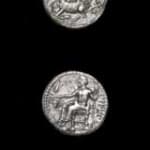Cilician Silver Stater Struck Under the Satrap Mazaios, 361 BCE - 334 CE
Silver
C.2058
Obverse: The God Baal Enthroned Facing Left Holding a Scepter, an Ear of Grain, and a Bunch of Grape Reverse: A Lion Attacking a Sta Cilicia is an ancient region...
Obverse: The God Baal Enthroned Facing Left Holding a Scepter, an Ear of Grain, and a Bunch of Grape
Reverse: A Lion Attacking a Sta
Cilicia is an ancient region of southeastern Asia Minor (modern Turkey), along the Mediterranean north of Cyprus. It included a high and barren plateau, Cilicia Trachia, an inhospitable region that served as shelter for pirates, and a richly fertile plain, Cilicia Pedias, that served as a strategic passageway throughout history. The area was under the domination of the Assyrian Empire before it became part of the Persian Empire. The Greeks settled on the coast early on, and Cilicia was Hellenized to a great extent. Tarsus was the capital of Cilicia and one of the most important cities in Asia Minor. Tarsus continued to flourish even after the region became part of the Roman Empire, reaching the height of its prosperity and cultural achievements, including being the birthplace of St. Paul.
Mazaios, a Persian nobleman, had a long and distinguished career. He was appointed satrap of Cilicia about 361 BC, and the region known as “Across the River” (modern Syria, Lebanon, and Israel) was later added to his domain. He fought against the Phoenicians of Sidon who revolted with the support of Pharaoh Nektanebo II and the Greek mercenary leader Mentor. Mazaios later served as the satrap of Mesopotamia and married Barsine, the daughter of Darius III. Famed historian Plutarch described him as “the greatest Persian after Darius.” This remarkable complement indicates that Mazaios might have simultaneously held the post of the Herzaraptis (the commanding officer of the Spearbearer’s Regimen) while serving as satrap. In 331 B.C., as Alexander the Great and his armies approached the great city of Babylon, Mazaios surrendered the city to him after gaining assurances that Babylon would not be plundered. Alexander rewarded Mazaios for his prudent decision by retaining him as governor, a position he held until his death in 328 BC.
How many hands have touched a coin in your pocket or purse? What eras and lands have the coin traversed on its journey into our possession? As we reach into our pockets to pull out some change, we rarely hesitate to think of who might have touched the coin before us, or where the coin will venture to after it leaves our hands. More than money, coins are a symbol of the state that struck them, of a specific time and location, whether contemporary currencies or artifacts of a long forgotten empire. This stunning hand-struck coin reveals an expertise of craftsmanship and intricate sculptural detail that is often lacking in contemporary machine-made currencies. This magnificent coin is memorial to an ancient governor, to the ancient glory of Tarsus, and to the greater Persian Empire, passed down from the hands of civilization to civilization, from generation to generation.
Reverse: A Lion Attacking a Sta
Cilicia is an ancient region of southeastern Asia Minor (modern Turkey), along the Mediterranean north of Cyprus. It included a high and barren plateau, Cilicia Trachia, an inhospitable region that served as shelter for pirates, and a richly fertile plain, Cilicia Pedias, that served as a strategic passageway throughout history. The area was under the domination of the Assyrian Empire before it became part of the Persian Empire. The Greeks settled on the coast early on, and Cilicia was Hellenized to a great extent. Tarsus was the capital of Cilicia and one of the most important cities in Asia Minor. Tarsus continued to flourish even after the region became part of the Roman Empire, reaching the height of its prosperity and cultural achievements, including being the birthplace of St. Paul.
Mazaios, a Persian nobleman, had a long and distinguished career. He was appointed satrap of Cilicia about 361 BC, and the region known as “Across the River” (modern Syria, Lebanon, and Israel) was later added to his domain. He fought against the Phoenicians of Sidon who revolted with the support of Pharaoh Nektanebo II and the Greek mercenary leader Mentor. Mazaios later served as the satrap of Mesopotamia and married Barsine, the daughter of Darius III. Famed historian Plutarch described him as “the greatest Persian after Darius.” This remarkable complement indicates that Mazaios might have simultaneously held the post of the Herzaraptis (the commanding officer of the Spearbearer’s Regimen) while serving as satrap. In 331 B.C., as Alexander the Great and his armies approached the great city of Babylon, Mazaios surrendered the city to him after gaining assurances that Babylon would not be plundered. Alexander rewarded Mazaios for his prudent decision by retaining him as governor, a position he held until his death in 328 BC.
How many hands have touched a coin in your pocket or purse? What eras and lands have the coin traversed on its journey into our possession? As we reach into our pockets to pull out some change, we rarely hesitate to think of who might have touched the coin before us, or where the coin will venture to after it leaves our hands. More than money, coins are a symbol of the state that struck them, of a specific time and location, whether contemporary currencies or artifacts of a long forgotten empire. This stunning hand-struck coin reveals an expertise of craftsmanship and intricate sculptural detail that is often lacking in contemporary machine-made currencies. This magnificent coin is memorial to an ancient governor, to the ancient glory of Tarsus, and to the greater Persian Empire, passed down from the hands of civilization to civilization, from generation to generation.



